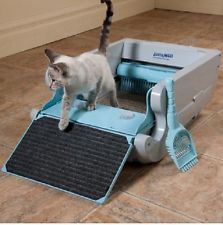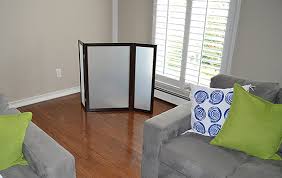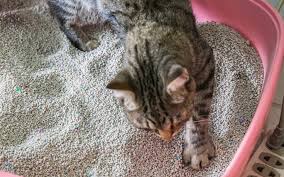Most cat owners would prefer if the litter box scooped and changed itself, or wish never gave off any unpleasant odors. Over the years there have been great strides taken in making this a reality, but is the perfect litter box for YOU actually perfect for YOUR CAT?
Cats can be very particular about the size, shape, depth and other attributes of their litter boxes. The box needs to be easily accessible, the cat needs to feel comfortable and there needs to be enough litter present to allow for digging. Otherwise, they will look for somewhere else to go.
To avoid messes outside the box and stress caused by not having the right box for your cat, keep these tips in mind when making your selection:
Material: The best material for a litter box is heavy, durable plastic since it’s easy to clean and holds up well over time.
Size: Litter boxes are made in a variety of space-saving sizes and shapes to minimize their presence, but for a cat to be comfortable, you will need a box 1.5 times the length of your cat. Oddly enough, most commercial litter boxes aren’t big enough for most cats to maneuver comfortably. Plus, the high sides make it difficult for older cats or those with arthritis to enter and exit. Always opt for the bigger size and look for one with a dip on one side to help your cat get in and out of the box with ease. An alternative is to use a plastic under-the-bed storage box – they are big enough for your cat to do their thing and the sides are low to allow easy access.

Covers: The best box to start with is a plain rectangular box. Although hooded litter boxes afford your cat privacy, help prevent the accidental spread of waste and urine, and help control odor, many cats dislike the pungent smells that can remain inside the covered box. So if you have a covered box and your cat is showing signs of displeasure (see below), try uncovering the box.
Cleaning: Most boxes serve as a pan to hold the litter which you will scoop manually. We prefer this method because it allows us to see the cat’s daily output. But there are also boxes with built-in cleaning mechanisms available, both manual and automatic, to make waste removal easier and extend the life of litter. Manual mechanisms incorporate some sort of sifting method and may require a specific type of litter to be used. Automatic ones are motion activated depositing the waste in a disposable container that you remove, empty, and rinse. It minimizes the handling of waste, however, a lot of times these mechanisms are scary to cats.
 Litter: There are lots of varieties of litter, which come in a range of textures and materials. Choose a litter that is unscented, absorbent, and as dust-free as you can find. Litters that contain dust can cause respiratory problems for cats when the dust is inhaled as the cat digs. Many cat owners prefer clumping litter over non-clumping as it is easier to remove both solid and liquid waste daily. Plus, it is the best way to keep tabs on your cat’s output and track any changes to make sure they remain healthy.
Litter: There are lots of varieties of litter, which come in a range of textures and materials. Choose a litter that is unscented, absorbent, and as dust-free as you can find. Litters that contain dust can cause respiratory problems for cats when the dust is inhaled as the cat digs. Many cat owners prefer clumping litter over non-clumping as it is easier to remove both solid and liquid waste daily. Plus, it is the best way to keep tabs on your cat’s output and track any changes to make sure they remain healthy.
Odor Control: You may be tempted to purchase scented litter or use litter box sprays to mask litter box odors. Many of these scents are too strong for cats, and your cat may choose to eliminate elsewhere to avoid the scent. To keep your litter box smelling fresh without scented litter, simply clean it more often.
Depth: You want to make sure your cat has enough litter for digging and adequate covering afterward. Most cat litter manufacturers recommend using 2 to 3 inches of litter. Every cat is an individual so pay attention to your cat’s litter box habits to see whether you need to adjust that level up or down. Note that adding extra litter will not reduce the amount of cleaning necessary.
Liners: The use of litter box liners is a personal preference. They are convenient for tidy disposal of used litter when it is time to empty and wash the box.
Number of boxes: Seldom will one litter box suffice. The rule of thumb is to have one more litter box than the number of cats present in the household. So, if you have 1 cat, you need 2 boxes. If you have 2 cats, you should have 3 litter boxes available. Sometimes cats benefit from having choices. Having too few litter boxes is a common cause of many toileting problems.
Location: Box location is critical. Make sure their litter is a good distance from their food and water in a private area free of clutter, obstacles, loud noises and distractions. If you are cramped for space, a screened-off corner of a room will work well.
Here are a few warning signs that your cat might want a different type or an additional litter box:
Spraying the sides or wall around the box: This can be especially common with covered litter boxes. Cats may try to tell others to “keep out” by spraying the litter box’s entry or the area around it.
Leaving pee or poop uncovered: Some cats just never develop the habit of covering their waste, but if your cat suddenly stops burying his urine or feces, it might be his way of telling other cats, “this box is mine.”
Eliminating outside the litter box: If your vet rules out medical reasons for the behavior change, your cat may be sending you a strong message that he’s not happy with the current litter box set-up.
Once you find a litter box/litter combination that works for your cat, stick with it! Cats are creatures of habit and introducing a new box or litter may take some adjusting
Tell us: How many litter boxes do you have in your home? What type works best for you and your cat?





Leave a Reply